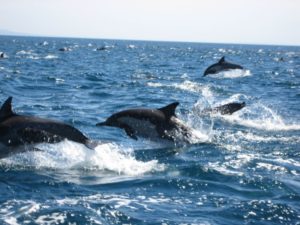by Todos Santos Eco Adventures
Scott Taylor, founder of the Australia-based Cetacean Studies Institute, wrote a magnificent book in 2003 titled Souls in the Sea: Dolphins, Whales and Human Destiny. Anyone who has interacted with the (free and wild) whales at Magdalena Bay, or swum with the (free and wild) dolphins in the Sea of Cortez, is aware on some level of the enormous intelligence of these beings, mammals who have inhabited the planet much longer than we have and, as Taylor argues, “possess a deep wisdom about how to live sustainably and joyfully.” In his book Taylor ponders why, after centuries of abuse, whales and dolphins continue to engage with humans. Is there something they are trying to tell us? Are they trying to change our perceptions of them? Taylor provides quotes from different writers who ponder the intelligence and messages of cetaceans:
It is an important and popular fact that things are not always what they seem. For instance, on the planet Earth, man had always assumed that he was more intelligent than dolphins because he had achieved so much – the wheel, New York, wars and so on – whilst all the dolphins had ever done was muck about in the waves having a good time. But conversely, the dolphins had always believed that they were far more intelligent than man – for precisely the same reason. — Douglas Adams, The Hitchhiker’s Guide to the Galaxy
Cetaceans unquestionably have big brains, and the frequency with which they use them in patterns that can only be described as play suggests that they frolic with their minds as readily as they do with their bodies. This tendency towards mental playfulness may in itself have been partly responsible for the enlargement of their brains.
— Lyall Watson and Tom Ritchie, Whales of the World
The brain of a dolphin prepared for microscopic examination reveals these things at the cellular le vel:
vel:
- The dolphin’s cell count is just as high per cubic millimeter as is that of a human.
- The connectivity, or number of cells connected to one another, is the same as that of a human brain.
- There is the same number of layers in the cortex of a dolphin as there is in a human brain.
In other words, this brain is as advanced as the human brain on a microscopic structural basis.
— Dr. John Lilly, Man and Dolphin
The cetacea hold an important lesson for us. The lesson is not about whales and dolphins, but about ourselves. There is at least moderately convincing evidence that there is another class of intelligent being on Earth beside ourselves. They have acted benignly and in many cases affectionately toward us. We have systematically slaughtered them.
— Carl Sagan, The Cosmic Connection
The dolphins had long known of the impending destruction of planet Earth and had made many attempts to alert humankind to the danger; but most of their communications were misinterpreted as amusing attempts to punch footballs or whistle for tidbits, so they eventually gave up and left Earth by their own means. The last-ever dolphin message was misinterpreted as a surprisingly sophisticated attempt to do a double-backward somersault through a hoop while whistling “The Star-Spangled Banner” – but, in fact, the message was this: “So long… And Thanks For All The Fish!”
